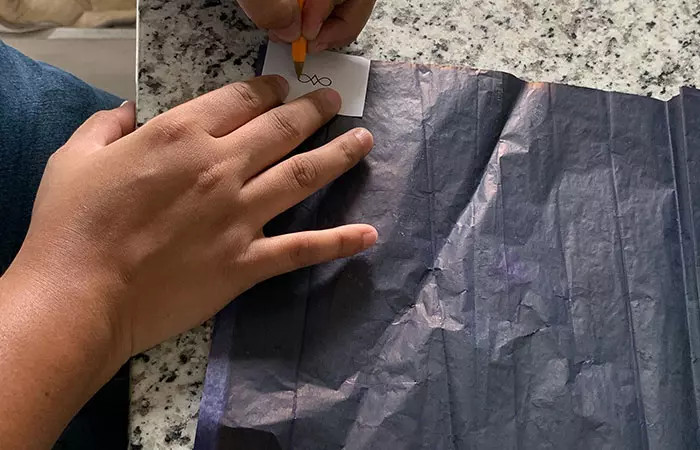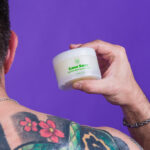Can You Use Vaseline To Transfer Tattoo Stencils? Yes, you can use Vaseline when transferring tattoo stencils because it helps to transfer a tattoo stencil smoothly and keep the skin moisturized. At tattooat.com, we understand the nuances of tattoo artistry, and that includes ensuring every stencil application is perfect for a great tattoo design. This comprehensive guide explores whether Vaseline is a good medium for tattoo stencil application, offering insights into its benefits, drawbacks, and best practices, ensuring your tattoo process is as smooth and professional as possible. Discover expert tips and advice on the best tattoo transfer methods for achieving crisp, clean lines every time.
1. What Is The Role Of A Tattoo Stencil In Tattooing?
A tattoo stencil serves as a blueprint for tattoo artists, ensuring precision and accuracy in their work. It transfers the design onto the skin, providing a clear outline to follow during the tattooing process. Using a stencil helps maintain the integrity of the design, allowing for detailed and complex artwork. A well-applied stencil is essential for achieving a high-quality, professional tattoo.
Why Is Accuracy Important When Applying Tattoo Stencils?
Accuracy is paramount when applying tattoo stencils to guarantee the final tattoo mirrors the intended design. Slight errors in stencil placement or transfer can lead to noticeable imperfections in the finished tattoo, impacting the overall look and satisfaction. Correct stencil application ensures symmetry, clean lines, and correct proportions, which are crucial for the artistic value of the tattoo.
What Are The Basic Steps For Applying A Tattoo Stencil?
The basic steps for applying a tattoo stencil include cleaning and prepping the skin, applying a stencil transfer solution, positioning the stencil firmly on the skin, and carefully removing the stencil paper. After removal, the design should be clearly visible on the skin, providing a precise guide for the tattoo artist. Allowing the stencil to dry completely before starting the tattoo is important to prevent smudging.
2. Can Vaseline Be Used As A Stencil Transfer Medium?
Yes, Vaseline can be used as a stencil transfer medium, providing a smooth base that helps the stencil adhere to the skin. Its emollient properties help keep the skin moisturized, which can aid in a clearer transfer. However, Vaseline should be used sparingly to avoid blurring the stencil lines. Many artists find it effective for simple designs, but it may not be the best choice for complex, highly detailed tattoos.
What Are The Potential Benefits Of Using Vaseline?
Potential benefits of using Vaseline include its wide availability, affordability, and moisturizing properties. Vaseline creates a protective barrier on the skin, reducing irritation during the stencil application. This can be particularly useful for clients with sensitive skin.
What Are The Drawbacks Of Using Vaseline For Tattoo Stencil Transfers?
Drawbacks of using Vaseline include its thick consistency, which can lead to smudging if too much is applied. It may also interfere with the tattoo ink’s ability to adhere properly to the skin, potentially affecting the tattoo’s longevity. Vaseline is not specifically designed for tattoo stencils, so it may not provide the same level of precision as professional transfer solutions.
3. How To Use Vaseline For Tattoo Stencil Application
To use Vaseline for tattoo stencil application, start by cleaning and shaving the area where the tattoo will be placed. Apply a very thin layer of Vaseline, ensuring the skin is lightly coated but not saturated. Place the stencil firmly on the Vaseline-covered area, holding it in place for a few minutes to allow the design to transfer. Carefully peel off the stencil paper and let the transferred design dry before starting the tattoo.
Step-By-Step Guide On Applying A Tattoo Stencil With Vaseline
- Prepare the Skin: Clean the area thoroughly with antibacterial soap and shave if necessary.
- Apply Vaseline: Use a small amount of Vaseline, spreading it thinly and evenly.
- Position the Stencil: Align the stencil carefully and press it onto the skin.
- Hold Firmly: Hold the stencil in place for 3-5 minutes to ensure proper transfer.
- Remove Stencil Paper: Gently peel off the stencil paper, leaving the design on the skin.
- Let it Dry: Allow the stencil to dry completely before beginning the tattoo.
Tips For Achieving A Clear And Lasting Stencil With Vaseline
To achieve a clear and lasting stencil with Vaseline, avoid using too much product, as this can blur the lines. Ensure the skin is completely clean before application. Press the stencil firmly and evenly to transfer the design fully. After removing the stencil, let the area dry completely before starting the tattoo.
4. Comparing Vaseline With Professional Stencil Solutions
When comparing Vaseline with professional stencil solutions, professional products generally offer better clarity and longevity of the stencil. These solutions are specifically formulated to create a strong bond between the stencil and the skin, reducing the risk of smudging. While Vaseline can work in a pinch, professional solutions provide more consistent and reliable results.
What Are The Advantages Of Using Professional Stencil Solutions?
Advantages of using professional stencil solutions include better adhesion, clearer stencil lines, and longer-lasting designs. These solutions are designed to work with various skin types and conditions, ensuring a reliable transfer every time. They also typically contain ingredients that help soothe and protect the skin during the tattooing process.
When Is It Better To Use A Professional Stencil Solution Over Vaseline?
It is better to use a professional stencil solution over Vaseline when working on intricate designs or when needing a stencil that lasts through longer tattoo sessions. If you have clients with oily skin or who sweat a lot, professional solutions provide better adhesion and prevent the stencil from fading. For artists aiming for the highest level of precision and quality, professional solutions are the preferred choice.
5. What Are The Best Alternatives To Vaseline For Tattoo Stencil Transfer?
The best alternatives to Vaseline for tattoo stencil transfer include stencil-specific transfer gels, green soap solutions, and certain types of deodorant sticks. Stencil transfer gels are formulated to provide a clear and lasting stencil. Green soap solutions offer a mild and effective way to prep the skin and aid in stencil application. Deodorant sticks can create a sticky base for the stencil to adhere to, but should be used with caution to avoid skin irritation.
Exploring Stencil-Specific Transfer Gels
Stencil-specific transfer gels are designed to provide the best possible stencil transfer, offering superior adhesion and clarity. These gels often contain ingredients that help soothe the skin, reducing redness and irritation. They are available from various brands and cater to different skin types, making them a versatile choice for tattoo artists.
Using Green Soap Solutions For Stencil Application
Green soap solutions are a mild and effective alternative for stencil application. Diluted green soap can clean the skin and provide a slightly tacky surface for the stencil to adhere to. This method is gentle on the skin and helps prevent irritation, making it suitable for clients with sensitive skin.
 Tattoo artist preparing the skin with green soap before applying a stencil.
Tattoo artist preparing the skin with green soap before applying a stencil.
6. Factors Affecting Tattoo Stencil Transfer Quality
Several factors affect tattoo stencil transfer quality, including skin type, cleanliness, and the type of transfer medium used. Oily skin can make stencil transfer more difficult, requiring thorough cleaning and a strong transfer solution. Dry skin may need extra moisturizing to help the stencil adhere properly. The quality of the stencil paper and the pressure applied during transfer also play crucial roles.
How Does Skin Type Affect Stencil Transfer?
Skin type significantly impacts stencil transfer. Oily skin can repel the stencil, requiring more rigorous cleaning and a stronger adhesive. Dry skin might absorb the stencil ink unevenly, leading to patchy results. Combination skin requires a balanced approach to ensure consistent transfer quality across different areas.
The Importance Of Skin Preparation Before Stencil Application
Proper skin preparation is vital for a successful stencil transfer. Cleaning the skin with antibacterial soap removes oils, dirt, and bacteria, providing a clean surface for the stencil. Shaving the area prevents hair from interfering with the stencil, ensuring a smooth and even transfer. Exfoliating can also help remove dead skin cells, improving stencil adhesion.
7. Common Mistakes To Avoid When Transferring Tattoo Stencils
Common mistakes to avoid when transferring tattoo stencils include using too much transfer medium, not cleaning the skin properly, and moving the stencil during application. Applying excessive amounts of Vaseline or transfer gel can cause the stencil to blur, while inadequate cleaning can prevent proper adhesion. Moving the stencil can result in a smudged or incomplete design.
Over-Application Of Transfer Medium
Over-application of transfer medium is a frequent mistake that can lead to blurry or distorted stencils. Using too much Vaseline or transfer gel creates a slippery surface, preventing the stencil from adhering correctly. Apply a thin, even layer of the transfer medium to avoid this issue.
Inadequate Skin Cleaning
Inadequate skin cleaning is another common error that hinders stencil transfer. Oils, dirt, and bacteria on the skin’s surface can prevent the stencil from making direct contact, resulting in a weak or incomplete transfer. Always clean the skin thoroughly with antibacterial soap and water before applying the stencil.
8. Advanced Techniques For Tattoo Stencil Application
Advanced techniques for tattoo stencil application include using stencil-setting sprays, double stenciling for complex designs, and custom stencil creation. Stencil-setting sprays help to prolong the life of the stencil, especially during long tattoo sessions. Double stenciling involves applying multiple stencils to create layered effects. Custom stencil creation allows artists to design and print their stencils for unique and personalized tattoos.
Using Stencil-Setting Sprays For Longevity
Stencil-setting sprays are designed to prolong the life of tattoo stencils, keeping them intact throughout the tattooing process. These sprays create a protective layer over the stencil, preventing it from fading or smudging. They are especially useful for complex designs that require extended tattooing sessions.
Double Stenciling For Complex Designs
Double stenciling is an advanced technique used for creating intricate and layered tattoo designs. It involves applying one stencil, tattooing certain elements, and then applying a second stencil to add additional details or shading. This method allows for greater precision and complexity in the final tattoo.
9. Maintaining A Clean Tattoo Stencil During The Tattooing Process
Maintaining a clean tattoo stencil during the tattooing process is crucial for preventing infections and ensuring the design remains clear. Regularly wipe the stencil with a sterile solution to remove excess ink and blood. Avoid touching the stencil with unsterilized hands or equipment. Use a barrier film to protect the stencil from contamination.
Best Practices For Wiping And Cleaning The Stencil
Best practices for wiping and cleaning the stencil include using sterile gauze or wipes soaked in a diluted green soap solution. Gently dab the stencil to remove excess ink and blood without smudging the design. Dispose of the used wipes immediately to prevent cross-contamination. Avoid using harsh chemicals or abrasive materials that could damage the stencil or irritate the skin.
Preventing Stencil Smudging During Long Sessions
Preventing stencil smudging during long sessions requires careful attention and proactive measures. Apply a stencil-setting spray to enhance adhesion. Periodically check the stencil for signs of fading or smudging, and reapply if necessary. Use a light touch when wiping the stencil to avoid accidental removal.
10. Expert Tips From Tattoo Artists On Stencil Application
Expert tips from tattoo artists on stencil application include always testing new transfer mediums on a small area of skin, using a light box to create precise stencils, and taking breaks during long stencil application sessions. Experienced artists also recommend investing in high-quality stencil paper and transfer solutions for the best results. Regularly seek feedback from other artists to improve your technique.
Insights From Professional Tattoo Artists
Professional tattoo artists emphasize the importance of patience and attention to detail when applying stencils. They advise beginners to practice on artificial skin before working on clients. Many artists also recommend using digital design software to create and modify stencils, ensuring the highest level of accuracy and customization.
Commonly Recommended Products By Tattoo Professionals
Commonly recommended products by tattoo professionals include:
| Product | Description |
|---|---|
| Stencil Stuff | A popular stencil transfer solution known for its reliable adhesion and clear stencil lines. |
| Green Soap | A mild and effective cleansing solution used to prepare the skin for stencil application. |
| Electrum Stencil Solution | A high-quality stencil solution that provides long-lasting stencils, ideal for complex designs and long tattoo sessions. |
| Dettol Antiseptic Liquid | (Diluted) Used by some artists for its antiseptic properties when cleaning the skin. Please note that opinions on using Dettol may vary. |
| A&D Ointment | Acts as a soothing protective barrier on freshly tattooed skin or before stencil application on dry skin. Please note that opinions on using A&D Ointment during tattooing may vary, as some artists find that it can clog needles or interfere with ink absorption. |
| Aloe Vera Gel | Acts as a soothing protective barrier on freshly tattooed skin or before stencil application on dry skin. |
| S8 Stencil Transfer Gel | A vegan stencil transfer solution known for its clear and precise stencil transfer, suitable for various skin types. |
| Medical-Grade Barrier Film | Used to protect the stencil and surrounding area from contamination during the tattooing process. |
| Thermal Copier / Stencil Pen | Used to create precise stencils from original designs. |
| Hectograph Paper | Allows for hand-drawn stencils. |
These insights and recommendations from experienced tattoo artists can help both beginners and seasoned professionals refine their stencil application techniques and achieve outstanding results.
Ultimately, while Vaseline can be used to transfer tattoo stencils, professional stencil solutions offer superior performance and reliability. Proper skin preparation, careful application, and the right techniques are essential for achieving a clear and lasting stencil.
Ready to elevate your tattoo artistry? Visit tattooat.com today for a wealth of design inspiration, a curated list of talented artists and studios, and expert articles on tattoo techniques. Find your next masterpiece and the perfect artist to bring it to life.
FAQ: Vaseline And Tattoo Stencils
1. Is Vaseline Safe To Use On Skin Before Tattooing?
Yes, Vaseline is generally safe to use on the skin before tattooing, as it creates a protective barrier and helps keep the skin moisturized. However, it should be applied in a thin layer to avoid interfering with the stencil or ink.
2. Can Vaseline Affect The Tattoo Ink?
Yes, Vaseline can affect the tattoo ink if applied excessively. It may prevent the ink from properly adhering to the skin, potentially leading to fading or uneven results.
3. How Much Vaseline Should I Use For Stencil Transfer?
You should use a very thin layer of Vaseline for stencil transfer. The skin should be lightly coated but not saturated.
4. What Should I Do If The Stencil Smudges After Applying Vaseline?
If the stencil smudges after applying Vaseline, gently wipe the area with a clean, dry cloth and reapply the stencil with a fresh, thin layer of Vaseline.
5. Can I Use Other Types Of Petroleum Jelly Instead Of Vaseline?
Yes, you can use other types of petroleum jelly instead of Vaseline, as long as they are pure and unadulterated.
6. Is Vaseline A Good Option For Clients With Sensitive Skin?
Vaseline can be a good option for clients with sensitive skin due to its hypoallergenic properties. However, always perform a patch test to ensure there is no adverse reaction.
7. How Long Should I Leave The Stencil On The Skin After Applying Vaseline?
You should leave the stencil on the skin for 3-5 minutes after applying Vaseline to ensure proper transfer.
8. Can I Reapply Vaseline During The Tattooing Process?
It is generally not recommended to reapply Vaseline during the tattooing process, as it may interfere with the ink. Use a specialized tattoo lubricant instead.
9. What Are The Best Cleaning Solutions To Use Before Applying Vaseline?
The best cleaning solutions to use before applying Vaseline include antibacterial soap, green soap solution, or rubbing alcohol.
10. Where Can I Buy Tattoo Stencils?
Tattoo stencils can be purchased online through websites like tattooat.com, at tattoo supply stores, or from specialized stencil manufacturers.

